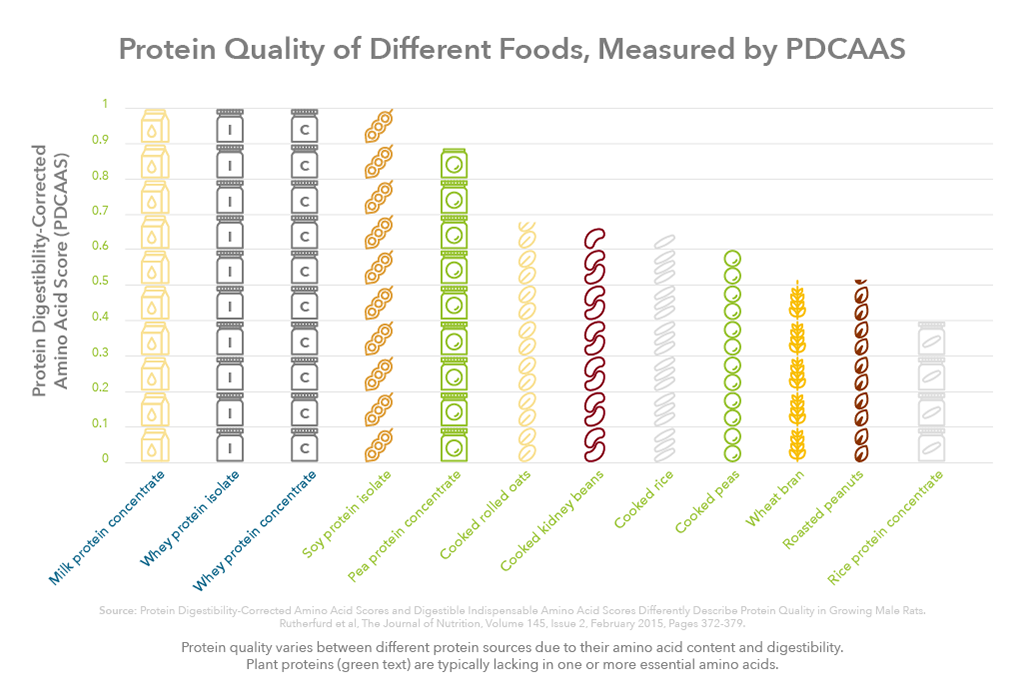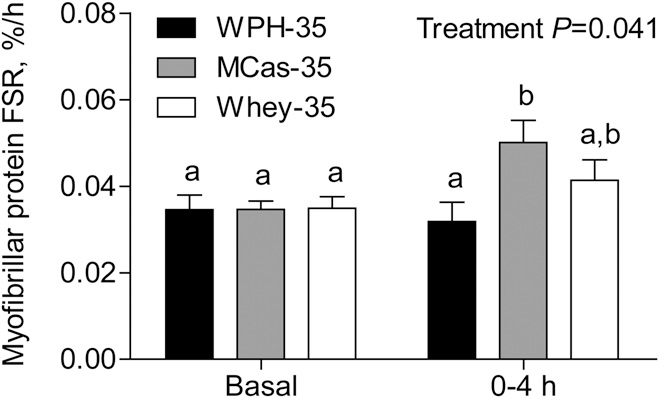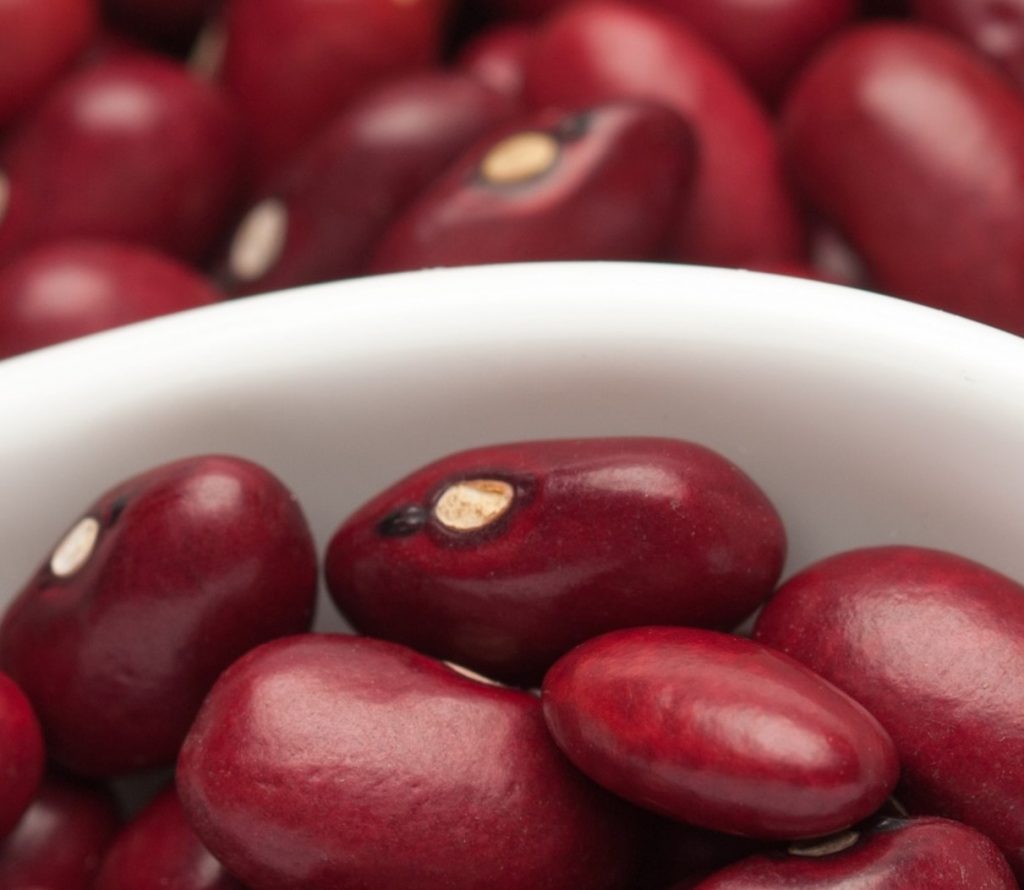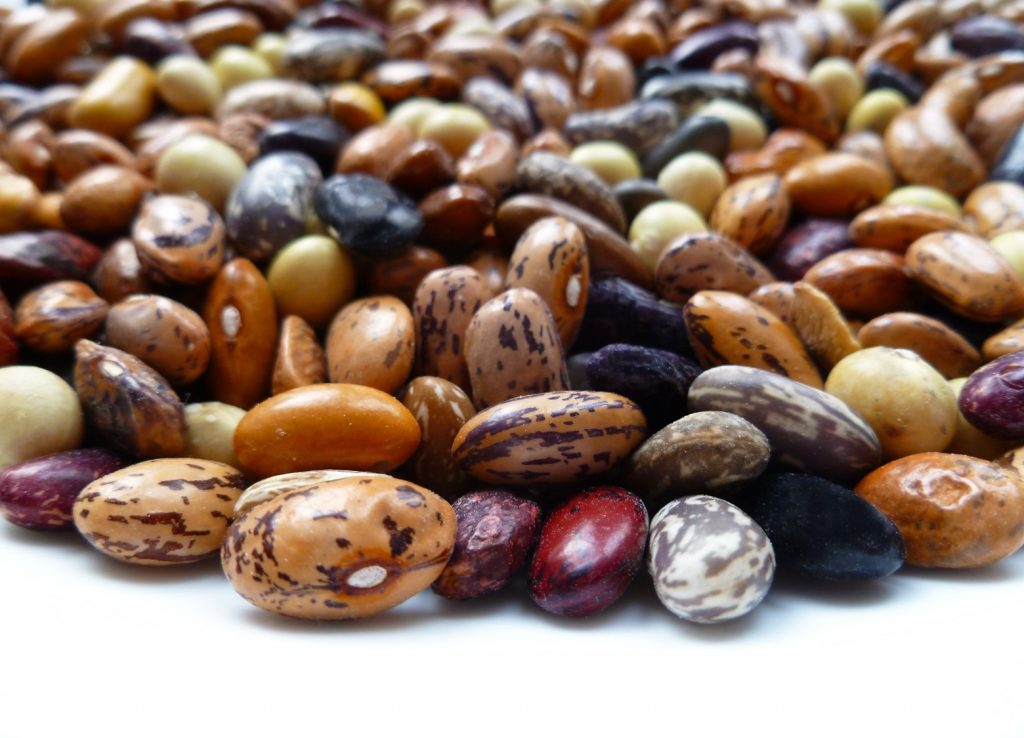In the article “Active Ageing – Why is Protein So Important?”, we showed how greater protein intakes at ages 50+ can fight the natural loss of muscle mass that comes with ageing, helping people keep active lifestyles later into life than if they didn’t consume adequate protein. Although plant proteins are seen as key to the future of the planet, they may have some limitations for supporting muscle health as we age. How can we improve plant proteins to maximize benefits for healthy ageing?
A study by Houston et al. (2008) showed that ageing adults who had a daily protein intake of 1.1 grams of protein per kilogram of body weight (around 88g per day for an 80kg male) lost 40% less muscle over the course of three years when compared to those who were consuming 0.8g/kg BW (around 64g per day for an 80kg male).
Let’s look at the science of plant proteins and muscle health, and how plant proteins could be optimised for active ageing.

Not all proteins are the same when it comes to healthy ageing
Plant proteins are often missing important amino acids or can be harder to digest
Most plant-based proteins are lower in certain essential amino acids than animal-based proteins and can also be harder to digest. This is reflected in the figure below, which uses a score called PDCAAS to represent the amino acid content of different proteins relative to the needs of the human body. Protein quality can also be measured using a score called DIAAS, which measures the amount of amino acids absorbed by the small intestine after protein is consumed.

What this chart shows is that consuming the same amount of whey protein compared to wheat protein will not result in the same amount of amino acids being absorbed into the body. In this example, the whey protein would provide all of the necessary amino acids for adequate muscle maintenance, whereas consuming the same amount of wheat protein would result in a lack of some of the amino acids the body needs.
When it comes to active ageing, this means plant proteins may be less efficient at activating muscle growth and repair and this must be considered when making recommendations for active ageing. For example, this article discusses the importance of leucine in activating muscle growth and repair. However, wheat protein has 37% less leucine than the same amount of whey protein (Herreman et al., 2020).
Plant proteins can be limited in their ability to stimulate muscle growth and repair in older individuals
The limited effectiveness of plant proteins to stimulate the muscle protein synthesis system, when compared to animal-derived protein, was shown by Gorissen et al. (2016) in a study where the ability of 35g of whey, casein, or wheat protein to stimulate muscle protein synthesis was measured in 60 healthy older men (70 -72 years old).

Myofibrillar protein synthesis (FSR), during the fasting state (Basal) and over the entire (0–4 h) postprandial period after the ingestion of 35g of wheat protein (WPH-35), 35g of casein protein (MCas-35), or 35g of whey protein (Whey-35) in healthy older men (Gorissen et al., 2016).
The results from the study, shown in the figure above, show that 35g of wheat protein had little to no impact on muscle protein synthesis beyond the baseline rate (i.e., resting rate before a meal).The subjects who consumed whey or casein proteins (which are animal derived) showed an increase in muscle synthetic response. The higher response to the consumption of the animal-derived whey and casein proteins is attributable to the greater content of essential amino acids, and higher overall digestibility which is reflected directly in their protein quality values: wheat=0.48, whey=0.85 and casein=1.17, as measured by DIAAS (Herreman et al., 2020).
The participants needed to eat almost twice as much wheat protein (60g) to see the same response in muscle protein synthesis as 35g of whey or casein. This would be a difficult amount of protein to eat in one sitting, especially in older individuals where diminished appetite is common. Another consideration is the environmental impact of growing the quantity of plant protein required to maintain this increased level of consumption which could counteract some of the benefits attributed to switching from animal protein to plant protein.
How can we improve the ability of plant proteins to support muscle health during ageing?

Choose the right protein source
Plant proteins with high protein quality scores are a good place to start when it comes to active ageing. Soy protein has a DIAAS value of 0.9, which is higher than most other plant sources. Soy protein has been shown to efficiently meet the body’s need to form new muscle but some negative perceptions around soy’s role in health, many of which are unwarranted, has led some consumers to stop consuming soy protein and search for other alternatives.
Pea protein (DIAAS value of 0.71) and rice protein (DIAAS value of 0.47) have become more prevalent and application of these ingredients is increasing over recent years. Emerging plant proteins of nutritional interest also include potato (DIAAS value of 1), pseudo-cereals (such as quinoa, amaranth and buckwheat), legumes (lentils, chickpeas and lupin) and oilseeds (canola, rapeseed and hemp) due to their levels of essential amino acids (Herreman et al., 2020; Martínez-Villaluenga et al., 2020). Mostly, methionine, cysteine, lysine and leucine are four essential amino acids that cause low DIAAS values for plant proteins and, therefore, limit their nutritional quality (Lonnie et al., 2018). Much scientific research has been conducted in this area to identify plant protein sources that are more nutritionally complete and have similar levels of these essential amino acids to that of soy and animal-derived proteins.
An alternative to finding a single source of plant protein which can act as complete source of nutrition for the healthy growth and maintenance of muscle in ageing individuals is to modify the physical, chemical or functional nature of plant proteins to optimise the effect they have on muscle growth and repair.
Improve digestibility via processing
One of the major limitations preventing plant proteins from having a high protein quality score is their limited digestibility and bioavailability. Within plants, proteins are usually encased in fibre-rich husks or layers that are very difficult for the body to digest, limiting our access to the protein when we eat it. Additionally, plants contain a range of bio-compounds, termed phytochemicals, which slow or inhibit protein digestion (Lonnie et al., 2018).
Physical processes such as cooking (i.e. heating), extrusion, drying, and enzymatic hydrolysis have all been shown to increase the digestibility of numerous plant proteins (Sá et al., 2019). For example, processing a soy flour into a soy protein isolate increases the PDCAAS score from 0.86 to 1.0. These processes can degrade the bio-compounds that limit digestibility or change the structure of the proteins to make them more accessible to the digestive enzymes in the intestine. These physical processing treatments (i.e. heating, wet fractionation, dry fractionation, drying, etc.,) are commonly used in the enrichment and isolation of plant proteins to produce protein-rich flours (e.g. protein concentrates or isolates), which results in the a large improvement in digestibility.
Blend different plant proteins together to improve amino acid profiles

Since many plant proteins are lacking in just a few essential amino acids, such as cereals being low in lysine and legumes being low in methionine, different plant protein sources can be blended to account for the other’s “amino acid weakness” so to speak. The right blend of rice and pea protein will have sufficient amounts of both lysine and methionine, creating a “complete” protein that is more efficient, gram for gram, at delivering amino acids to our muscles than either protein alone.
Plant-animal protein blends are also a possibility, since the plant-based market has expanded beyond vegans and vegetarians to flexitarians or those just looking to eat more plant-based foods. Blends of plant and animal proteins have already seen some use to enhance the functionality (e.g. solubility, taste, texture) of plant proteins in foods and beverages. A series of studies have tested the ability of milk protein, soy protein and a milk-soy protein blend to stimulate protein synthesis after exercise in both older men and young adults. Results from these studies showed that the muscle protein synthesis rates were higher and remained higher for a longer period of time for the milk-soy protein blend (Borack et al., 2016; Reidy et al., 2014, 2013), suggesting possible health benefits in consuming a plant-animal blend of protein. More research would be needed to fully understand how different protein blends interact and their potential health benefits.
Increase leucine content of plant protein
As mentioned earlier, the amino acid leucine has an important role in activating muscle growth and repair. Many plant proteins contain around 20-30% less leucine than animal proteins, although there are a few plants high in leucine, such as corn, soy, and potato (Herreman et al., 2020). It stands to reason, then, that adding leucine to plant proteins or breeding plants to contain higher levels of leucine might improve their ability to promote active ageing.
A study by Wall et al. (2013) found that the addition of crystalline leucine (2.5g) to a 20g serving of casein had a greater effect on protein synthesis compared to the consumption of 20g of casein alone. Although this study used animal-sourced protein, it shows that addition of leucine can help overcome the reduced sensitivity of the mTOR system (responsible for initiating muscle growth and repair) that is seen during ageing. A study done in mice found that adding leucine to a wheat protein to match the leucine content typically found in whey protein led to a similar ability to stimulate muscle growth compared to whey (Norton et al., 2012).
Conclusion
To promote active ageing it is key that not only the right quantity of protein is consumed but the quality of the protein should also be considered. There are actionable strategies such as processing, protein blending, or targeting leucine content that can improve the ability of plant proteins to promote active ageing while also addressing growing concerns over the environmental impact of animal proteins.
Contributor:
-
References
Borack, M.S., Reidy, P.T., Husaini, S.H., Markofski, M.M., Deer, R.R., Richison, A.B., Lambert, B.S., Cope, M.B., Mukherjea, R., Jennings, K., Volpi, E., Rasmussen, B.B., 2016. Soy-dairy protein blend or whey protein isolate ingestion induces similar postexercise muscle mechanistic target of rapamycin complex 1 signaling and protein synthesis responses in older men. J. Nutr. 146, 2468–2475. https://doi.org/10.3945/jn.116.231159
Gorissen, S.H.M., Witard, O.C., 2018. Characterising the muscle anabolic potential of dairy, meat and plant-based protein sources in older adults. Proc. Nutr. Soc. 77, 20–31. https://doi.org/10.1017/S002966511700194X
Herreman, L., Nommensen, P., Pennings, B., Laus, M.C., 2020. Comprehensive overview of the quality of plant- And animal-sourced proteins based on the digestible indispensable amino acid score. Food Sci. Nutr. https://doi.org/10.1002/fsn3.1809
Lonnie, M., Hooker, E., Brunstrom, J.M., Corfe, B.M., Green, M.A., Watson, A.W., Williams, E.A., Stevenson, E.J., Penson, S., Johnstone, A.M., 2018. Protein for life: Review of optimal protein intake, sustainable dietary sources and the effect on appetite in ageing adults. Nutrients 10. https://doi.org/10.3390/nu10030360
Martínez-Villaluenga, C., Peñas, E., Hernández-Ledesma, B., 2020. Pseudocereal grains: Nutritional value, health benefits and current applications for the development of gluten-free foods. Food Chem. Toxicol. 137. https://doi.org/10.1016/j.fct.2020.111178
Norton LE, Wilson GJ, Layman DK, Moulton CJ, Garlick PJ. Leucine content of dietary proteins is a determinant of postprandial skeletal muscle protein synthesis in adult rats. Nutr Metab (Lond) 2012;9:67.
Reidy, P.T., Walker, D.K., Dickinson, J.M., Gundermann, D.M., Drummond, M.J., Timmerman, K.L., Cope, M.B., Mukherjea, R., Jennings, K., Volpi, E., Volpi, E., Rasmussen, B.B., 2014. Soy-dairy protein blend and whey protein ingestion after resistance exercise increases amino acid transport and transporter expression in human skeletal muscle. J. Appl. Physiol. 116, 1353–1364. https://doi.org/10.1152/japplphysiol.01093.2013
Reidy, P.T., Walker, D.K., Dickinson, J.M., Gundermann, D.M., Drummond, M.J., Timmerman, K.L., Fry, C.S., Borack, M.S., Cope, M.B., Mukherjea, R., Volpi, E., Rasmussen, B.B., 2013. Protein blend ingestion following resistance exercise promotes human muscle protein synthesis. J. Nutr. 143, 410–416. https://doi.org/10.3945/jn.112.168021
Sá, A.G.A., Moreno, Y.M.F., Carciofi, B.A.M., 2019. Food processing for the improvement of plant proteins digestibility. Crit. Rev. Food Sci. Nutr. https://doi.org/10.1080/10408398.2019.1688249
Wall BT, Hamer HM, de Lange A, Kiskini A, Groen BB, Senden JM, Gijsen AP, Verdijk LB, van Loon LJ. Leucine co-ingestion improves post-prandial muscle protein accretion in elderly men. Clin Nutr. 2013 Jun;32(3):412-9.

 Ryan Hazlett (MSc) is an expert in the processing and application of nutritional ingredients, such as protein, into powders for use in foods and beverages. He is currently a RD&A technologist who joined Kerry Taste & Nutrition in 2020.
Ryan Hazlett (MSc) is an expert in the processing and application of nutritional ingredients, such as protein, into powders for use in foods and beverages. He is currently a RD&A technologist who joined Kerry Taste & Nutrition in 2020. 

